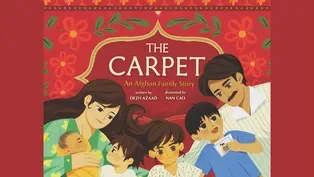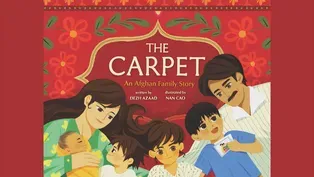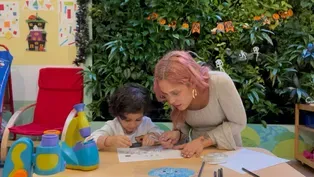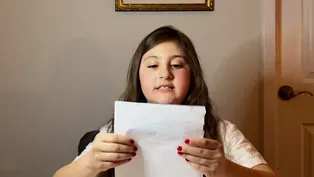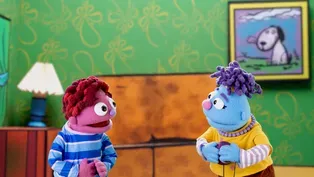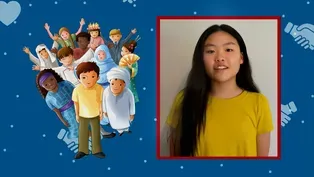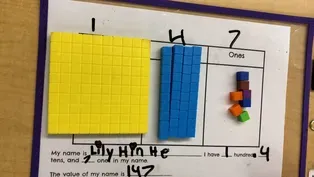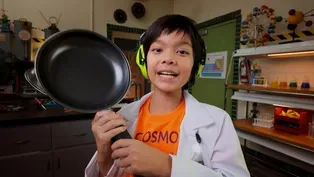
CREEPY CREATURES THAT HELP US
Clip: 7/22/2024 | 5m 22sVideo has Audio Description, Closed Captions
Learn how animals that may seem creepy – like rat snakes and vultures – do important jobs
Learn how animals that may seem creepy – like rat snakes and vultures at the Houston Zoo – do important jobs that help people and the environment.
See all videos with Audio DescriptionADProblems with Closed Captions? Closed Captioning Feedback
Problems with Closed Captions? Closed Captioning Feedback
Let's Learn is a local public television program presented by THIRTEEN PBS

CREEPY CREATURES THAT HELP US
Clip: 7/22/2024 | 5m 22sVideo has Audio Description, Closed Captions
Learn how animals that may seem creepy – like rat snakes and vultures at the Houston Zoo – do important jobs that help people and the environment.
See all videos with Audio DescriptionADProblems with Closed Captions? Closed Captioning Feedback
How to Watch Let's Learn
Let's Learn is available to stream on pbs.org and the free PBS App, available on iPhone, Apple TV, Android TV, Android smartphones, Amazon Fire TV, Amazon Fire Tablet, Roku, Samsung Smart TV, and Vizio.
Providing Support for PBS.org
Learn Moreabout PBS online sponsorship[uplifting music] - Are all snakes venomous?
Are bats really blind?
Can owls really turn their heads all the way around?
Let's take a look at these animal myths and stories.
Now, a myth is something that many people believe is true, even if it's not.
Many of these myths were created to explain how the world works before we really understood what was going on around us.
Also, many people can't tell you when or where they first heard a myth.
One common myth is that you can get warts just by touching a frog or a toad.
Who came up with that?
Now, the myths today are about animals you might think are scary, gross, or creepy.
But these animals actually have amazing adaptations that help them and us too.
With some cool science and fact-checking, we'll see if we can learn more about these animals and dispel some of those myths.
To do that, I ask that each of you keep an open mind.
For me, when I keep an open mind, I like to pop my mind open [imitates popping] and take out all the negative thoughts and opinions I have that aren't based in fact, things like snakes are slimy.
It's not a fact, just gonna throw that away.
Bats are creepy because they come out at night.
Don't need that in there.
Vultures are gross because of the food that they eat.
Once I've tossed all those negative thoughts away, my mind is now open and ready for the facts we're gonna share.
While we may not change your mind about some of these animals, hopefully, with a little bit more information, we can help you find a way to still appreciate them.
Let's start exploring.
[dreamy music] - [Announcer 3] For all the fear and hate that snakes evoke, they inspire fascination like few other species.
And here in Houston, Texas, rat snakes are the most common long snake in our area.
At up to seven feet long, these snakes have dark blotches on lighter-colored skin.
Because of their coloring, many people confuse rats snakes with rattlesnakes, and that's just what the rat snake is hoping for.
This non-venomous snake defends itself by using a fake-out.
Like some other snakes, they can rapidly whip the end of their tails back and forth against anything nearby to create a rattling sound.
They're also very good climbers.
So if you see a snake in a tree, it's most likely a rat snake.
And it's up there doing its job.
And boy, do these guys have an important job.
Rat snakes help keep the local population of rats and mice in check.
You'll find it snacking on small mammals, birds, and reptiles.
And if you find one in your yard, you're lucky.
That means you have your very own personal pest control officer.
This is Ferdinand, and he's named after the man that discovered rats snakes in Texas, one Mr. Ferdinand Jacob Lindheimer.
Whenever he is in training for his ambassador job, he likes to lay on his heating pad or sleep under his water bowl.
[dreamy music fades] Vultures are very beneficial birds that help the environment and people.
In North America, we have three species of vulture you may have seen or heard of: turkey vultures, black vultures, and California condors.
[blissful music] They are commonly found in large groups near relatively open and clear spaces for scavenging and wooded tree areas for nesting.
Turkey vultures have great eyesight and a good sense of smell to detect fresh carrion, which is a remarkable trait for a bird.
Carrion is the term for carcasses that vultures eat.
Most birds lack a strong nose.
Black vultures are often seen nearby because they cannot smell the way turkey vultures can and will follow along to find carcasses.
Their diet and preference for eating fresh carrion allows them to dispose of or consume meat that would have otherwise become a breeding ground for disease as it decayed.
Vultures help keep the world a much cleaner place.
If you have ever seen a vulture flying in circles, you may have wondered what they were doing.
Some people think they hover over a sickly or dying animal waiting for them to pass for a free meal.
This is a common misconception as we often see it and don't know how to explain the behavior.
What is really happening is an example of static soaring, a really neat technique that some birds have to use rising thermals or air currents to stay up in the sky without having to flap their wings so much.
It just so happens that the spaces vultures do this might seem to look desolate out over an empty field or a hot stretch of desert because of how air currents work.
You don't usually get good lift right by the tree line.
Here at the Houston Zoo, we have a black vulture, Dudley, who lives in the Children's Zoo, and two king vultures.
THE CARPET: AN AFGHAN FAMILY STORY
Video has Audio Description, Closed Captions
Clip: 7/22/2024 | 3m 44s | Anna Scretching-Cole reads THE CARPET: AN AFGHAN FAMILY STORY, written by Dezh Azaad. (3m 44s)
THE CARPET: AN AFGHAN FAMILY STORY ASL
Video has Audio Description, Closed Captions
Clip: 7/22/2024 | 3m 44s | Anna Scretching-Cole reads THE CARPET: AN AFGHAN FAMILY STORY, written by Dezh Azaad. (3m 44s)
Video has Audio Description, Closed Captions
Clip: 7/22/2024 | 8m 26s | Learn how everyone has unique fingerprints with Brooklyn Preschool of Science. (8m 26s)
EVIE WRITES AN ADVOCACY LETTER!
Video has Audio Description, Closed Captions
Clip: 7/22/2024 | 55s | Evie writes a letter to an assembly member asking for a playground to open earlier. (55s)
FEEL YOUR BEST SELF: BELLY BREATHING
Video has Audio Description, Closed Captions
Clip: 7/22/2024 | 5m 2s | Use a strategy called “belly breathing” to feel better when you are mad or sad. (5m 2s)
Video has Audio Description, Closed Captions
Clip: 7/22/2024 | 2m 41s | Sing “I am Love,” a song of affirmations, with Fyütch and his daughter. (2m 41s)
Video has Audio Description, Closed Captions
Clip: 7/22/2024 | 9m 46s | Learn about the long "oo" sound with Anna Scretching-Cole. (9m 46s)
MEET THE HELPERS: BE A CHANGEMAKER!
Video has Audio Description, Closed Captions
Clip: 7/22/2024 | 47s | Meet a changemaker! Changemakers work to make the world a better place. (47s)
WHAT IS THE VALUE OF YOUR NAME?
Video has Audio Description, Closed Captions
Clip: 7/22/2024 | 8m 8s | Tahese Warley plays a math game with three-digit place value. (8m 8s)
WORDSVILLE: THE CASE OF THE NOT-SO-TRANQUIL TOWN
Video has Audio Description, Closed Captions
Clip: 7/22/2024 | 7m 26s | Vet Wilder's "tranquility" sign disappeared from his clinic, making Wordsville boisterous! (7m 26s)
Providing Support for PBS.org
Learn Moreabout PBS online sponsorshipSupport for PBS provided by:
Let's Learn is a local public television program presented by THIRTEEN PBS
